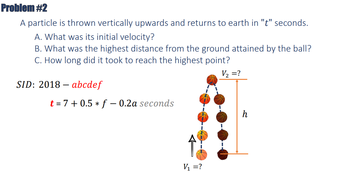Question

Transcribed Image Text:Problem #2
A particle is thrown vertically upwards and returns to earth in "t" seconds.
A. What was its initial velocity?
B. What was the highest distance from the ground attained by the ball?
C. How long did it took to reach the highest point?
V₂ =?
SID: 2018-abcdef
t = 7+0.5 * f- 0.2a seconds
V₁ =?
h
Expert Solution
This question has been solved!
Explore an expertly crafted, step-by-step solution for a thorough understanding of key concepts.
Step by stepSolved in 4 steps

Knowledge Booster
Similar questions
- At 10:17 a.m., you pass a police car at 55 mph that is stopped on the freeway. You pass a second police car at 55 mph at 10:53 a.m., which is located 39 mi from the first police car. If the speed limit is 60 mph, can the police cite you for speeding? а. a. The total time between your two police car sightings was P hours. b. Your average speed between the two police car sightings was 8, mph. c. Can the police cite you for speeding? No, your average speed was less than the speed limit. CYes, since your average speed was more than the speed limit, there must have been somewhere within the 39 mi where you were driving more than 60 mph.arrow_forwarda. Find the velocity v(t) and acceleration a(t). b. At what value of t does v=0? c. What is the maximum height?arrow_forward3. A quarterback throws a football with initial velocity components Voy= 10.0 m/s (upward) and Vax = 19.0 m/s (down the field). It is caught at the same height it is thrown from. a. How long does it take for the football to reach its maximum height? b. How high is this point above where the ball was released? c. How much time, after it was thrown, elapses before the ball is caught? Compare this time to what you found in part (a). d. How far away from the quarterback is the ball when it is caught? 4. Repeat question 3, but have the initial speed of the ball be 28.0 m/s and the initial angle be 38.0° up from horizontal.arrow_forward
- S-1 pt S-1 pt 1. Jason is racing his dirt bike and comes out of a turn into a long straightaway going a velocity of 15m/s and accelerates at a rate of 2m/s^2. Jason accelerates for 6 seconds. How much distance does Jason cover in that time period? G-Given (what are the givens in the problem) * v-15m/sarrow_forward4. A jogger warms up by running 350 meters east at an average speed of 3.8 m/s, then running west 240 meters at an average speed of 4.2 m/s. a. How much time does the first part of the trip take? b. How much time does the second part of the trip take? c. How long does the entire trip take? d. What is the total distance for the entire trip? e. What is the magnitude of the jogger's displacement for the entire trip? f. What is the average speed for the entire trip? g. What is the magnitude of the jogger's average velocity for the entire trip?arrow_forward5. The x-location and y-location of a particle are described by the following equations, where x and y are in meters and time is in seconds: x = 4e-t y = 2 + 8e -2t a. What is the equation of the particle's path in the x-y plane? b. What are the (x,y) coordinates of the particle at time=0 and as time → ∞o? c. What is the speed of the particle at time=0?arrow_forward
arrow_back_ios
arrow_forward_ios